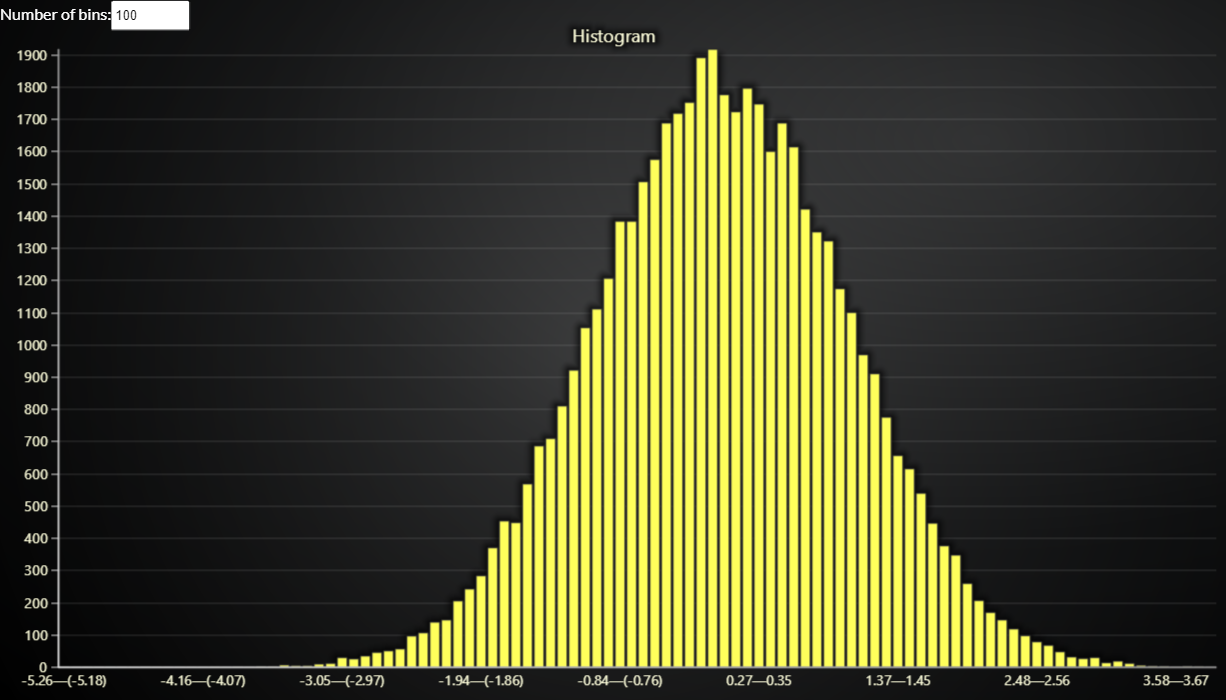JavaScript Histogram of Gaussian Distribution.
This demo application belongs to the set of examples for LightningChart JS, data visualization library for JavaScript.
LightningChart JS is entirely GPU accelerated and performance optimized charting library for presenting massive amounts of data. It offers an easy way of creating sophisticated and interactive charts and adding them to your website or web application.
The demo can be used as an example or a seed project. Local execution requires the following steps:
-
Make sure that relevant version of Node.js is installed
-
Open the project folder in a terminal:
npm install # fetches dependencies npm start # builds an application and starts the development server -
The application is available at http://localhost:8080 in your browser, webpack-dev-server provides hot reload functionality.
Description
Example showcasing LightningChart Histogram visualization using Bar Chart.
Bar Chart can be used as a histogram by calculating the bins manually using the following function:
const calculateHistogramBins = (data, numberOfBins) => {
const minValue = Math.min(...data)
const maxValue = Math.max(...data)
const binSize = (maxValue - minValue) / numberOfBins
// Calculate bin intervals
const bins = []
for (let i = 0; i < numberOfBins; i++) {
const binStart = minValue + i * binSize
const binEnd = minValue + (i + 1) * binSize
bins.push({
binStart: parseFloat(binStart.toFixed(2)),
binEnd: parseFloat(binEnd.toFixed(2)),
values: Array(),
})
}
bins[numberOfBins - 1].binEnd = maxValue
// Map data to bins
data.forEach((value) => {
const binIndex = Math.floor((value - minValue) / binSize)
if (binIndex >= 0 && binIndex < numberOfBins) {
bins[binIndex].values.push(value)
}
})
// Create input data for bar chart
const barChartData = []
bins.forEach((interval) => {
barChartData.push({
category: `${(interval.binStart + (interval.binStart === minValue ? 0 : 0.01)).toFixed(2)}—${
interval.binEnd < 0 ? `(${interval.binEnd.toFixed(2)})` : interval.binEnd.toFixed(2)
}`,
value: interval.values.length,
})
})
return barChartData
}In this example, a normally distributed dataset is generated by the Box–Muller transform method:
const generateGaussianRandom = (length) => {
const samples = []
for (let i = 0; i < length; i++) {
let u = 0,
v = 0,
s = 0
while (s === 0 || s >= 1) {
u = Math.random() * 2 - 1
v = Math.random() * 2 - 1
s = u * u + v * v
}
const temp = Math.sqrt((-2 * Math.log(s)) / s)
const sample = u * temp
samples.push(sample)
}
return samples
}In order to preserve the bell curve shape, automatic sorting has to be turned off by barChart.setSorting(BarChartSorting.Disabled)
The number of histogram bins can be changed dynamically by the user using the HTML number input. The chart updates automatically from these interactions.
API Links
- Bar Chart
- Bar Chart Bar
- Bar Chart Value Axis
- Bar Chart Category Axis
- Bar Chart Types
- Bar Chart Sorting
Support
If you notice an error in the example code, please open an issue on GitHub repository of the entire example.
Official API documentation can be found on LightningChart website.
If the docs and other materials do not solve your problem as well as implementation help is needed, ask on StackOverflow (tagged lightningchart).
If you think you found a bug in the LightningChart JavaScript library, please contact support@lightningchart.com.
Direct developer email support can be purchased through a Support Plan or by contacting sales@lightningchart.com.
© LightningChart Ltd 2009-2022. All rights reserved.
